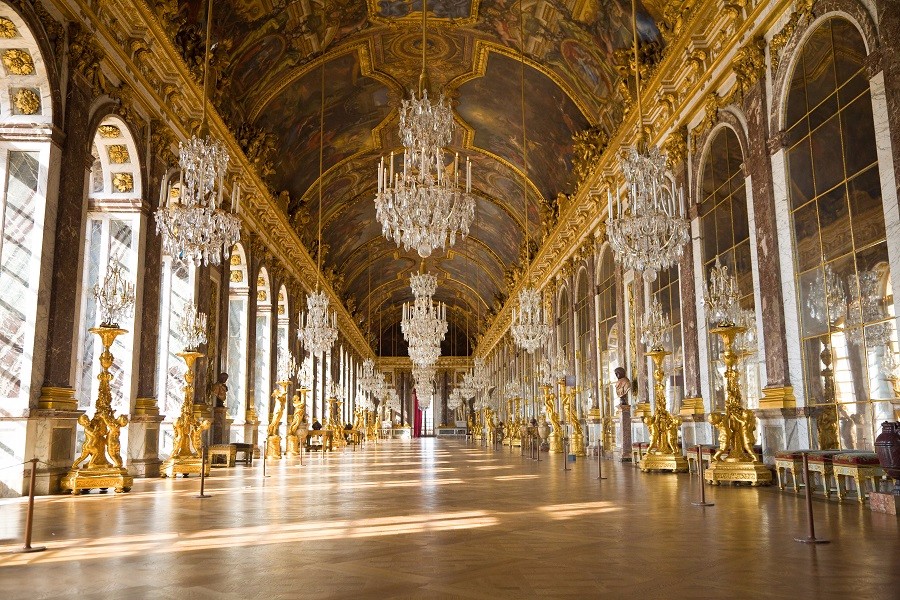
La Galerie des Glaces
The chateau de Versailles has a lot of places and rooms that make one look around in awe, but the most impressive of them all is most likely the Hall of Mirrors aka the Galerie des Glaces. If you have been to Versailles, you probably remember very well what you thought the first time to stepped into the massive hall and it probably was something like woooooow.
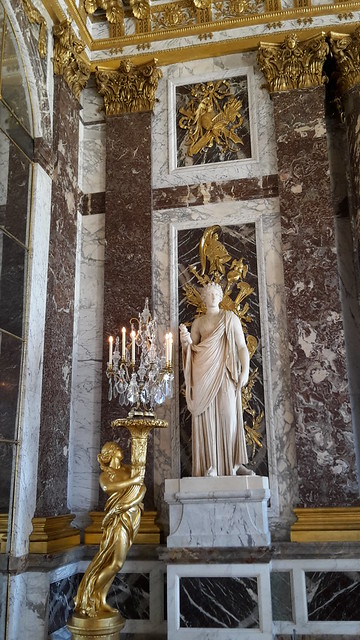 Imagine how the 17th century courtier must have felt, especially those from the province, as they set their eyes on it for the first time. (Is this the real life? Is this just fantasy?) What is an amazing sight to behold for us today, was a sight that truly blew the minds of many.
Imagine how the 17th century courtier must have felt, especially those from the province, as they set their eyes on it for the first time. (Is this the real life? Is this just fantasy?) What is an amazing sight to behold for us today, was a sight that truly blew the minds of many.
Before there was a Galerie des Glaces, Versailles featured a terrace on the very spot with the King’s apartment on side and the Queen’s on the other. While that looked nice and was good spot to behold the gardens, it also exposed everyone who crossed it to the weather and if it rained a lot, there often were leaks in the rooms below. At this point Louis XIV also thought Versailles was still lacking something, which could be found in other residences. A proper gallery.
The Sun King wanted a proper gallery as well, especially after he had seen his brother’s fabulous gallery at Saint-Cloud. Thus it was decided to create a gallery so splendid that it would outdo all others.
The third building campaign of Versailles, led by Jules Hardouin-Mansart, made it happen. It was decided, among other things, to use the spot occupied by the terrace to create a large gallery, then called the Grande Galerie. Before the construction began in 1678, Louis XIV was presented with various plans of how the gallery could look and he had a bit of a hard time deciding. In the end, he went for a gallery bordering on salons, which opened into the King’s apartment in the north and Queen’s apartment in the south.
The gallery that was created between 1678 and 1684, features 17 tall arched windows to allow as much light and sun to enter the large room and also to enable all that walk inside to behold the gardens, as if one was outside and inside at the same time. To make this effect even stronger, it was decided to place mirrors on the opposite side of the windows. Those mirrors would reflect the sun during the day and the candle light during the evening, thus illuminating everything day and night… but there was a bit of a problem.
Not only were mirrors very expensive, so expensive in fact that even nobles could only afford small ones, and a lot of mirrors were needed, but the monopoly in mirror-making was held by Venice and all materials used for Versailles ought to be French. The creation of a mirror was very difficult and only the most skilled people could execute it to perfection…. Venice knew that and thus keep a close eye on their mirror-workers.

Jean-Baptiste Colbert came up with a plan and actually managed to lure some workers away from Venice to France for his very French manufacture royale de glaces de mirrors, which created no less than 350 mirror plates to be installed in the gallery. This way the Sun King could subtly show off his immense wealth and that France could create mirrors just as good as Venice. According to rumours, Venice then even send people after the workers in France to poison them in order to keep the mirror monopoly.
Finding the proper theme for the decorations was another issue. Louis XIV couldn’t quite make his mind up about it. In first, he wanted to take the theme of Apollo, but rejected it after realising his brother had used the same theme for the gallery at Saint-Cloud…. and the Louvre already had a Apollo gallery as well. It was then suggested that instead of Apollo, Hercules could be the theme… or rather Louis XIV himself disguised as Hercules. Louis liked that idea… for a while.
After much back and forth, Louis decided that he did not need a disguise, no matter if it would be Apollo or Hercules or any other God or Hero. He was the centre of France after all and the centre of his palace, the heart of France, could just as well celebrate him and his achievements, the first twenty years of his reign and military victories, all sans disguise. For the furniture, Louis decided that it should be made of silver. Actual silver and not just wood covered in silver.
If we think of the Hall of Mirrors today, we consider it to be a sort of large ballroom. It was indeed the sight of large receptions and festivities, but it was most of the time just one huge waiting room.
The gallery served as a roofed promenade in which courtiers and visitors could stroll, exchange news, gossip, show off their new garments and most importantly wait for the King to show himself. Louis XIV did so at least once during the day, in the morning on the way from his bedroom to the chapel, and the Hall of Mirrors was packed with people then. Everyone came to see the King, to be seen by him and the rest of the court. If one had a request, one could attempt to catch the King’s eye in hopes to be acknowledged with a nod and to, maybe, forward said request. At the same time, the dimensions of the gallery, 73.0 m in length × 10.5 m wide × 12.3 m high, made it possible for Louis XIV to easily pretend not to have seen someone or move away from people who were not in his favour or he considered to be a bit annoying.
Louis XIV’s Grande Galerie was envied by all of Europe and thus copied in various forms and sized in many residences. The most famous copy is the gallery of the German Schloss Herrenchiemsee built by the fairy-tale King Ludwig II. The one at Herrenchiemsee is even larger than the original at Versailles and decked out with more gold…
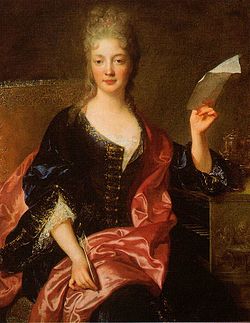



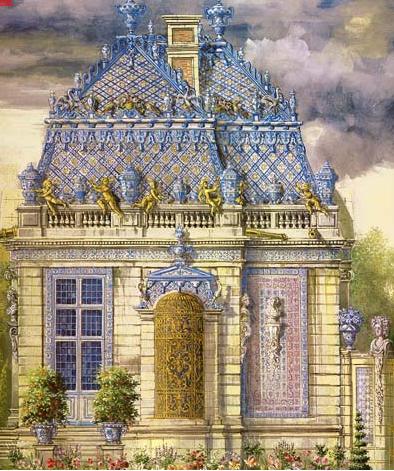
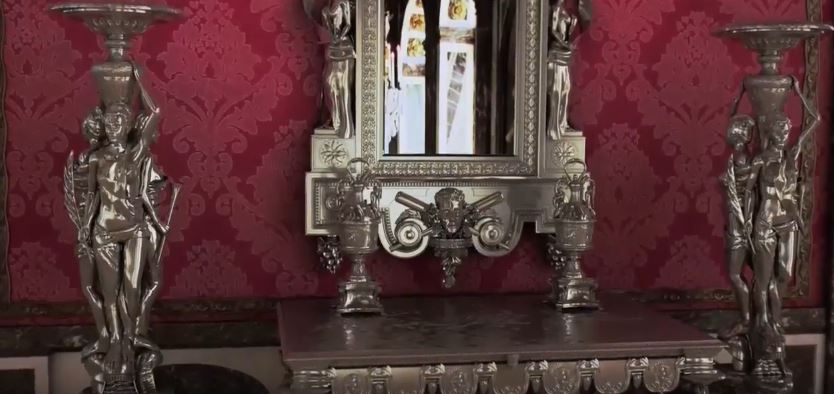
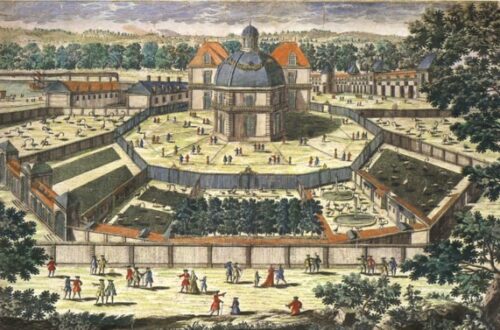
3 Comments
Tess
Thanks for showing us those rarely seen pictures of the Hall of Mirrors’ decorations.
And I have to say once again, what a pity that Palace of Saint Cloud didn’t survive till now. It would be fabulous to compare both of galleries.
Maria Barrô
I saw the “La Galerie des Glaces” last year in March and my frist impression was of amazement,something out of this world!
Debra L Taylor
I do so much wish that Prince Philippe’s residence at St. Cloud had survived — I would love to see it, room by room. I always wonder what it would be like to compare St. Cloud with Versailles and see how much each residence reflected the personality of the brother that created it.